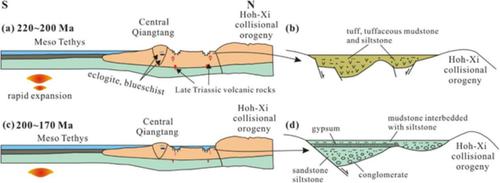当前位置:
X-MOL 学术
›
Geolog. J.
›
论文详情
Our official English website, www.x-mol.net, welcomes your
feedback! (Note: you will need to create a separate account there.)
Geochemistry and detrital zircon geochronology of the Lower Jurassic clastic rocks of the northern Qiangtang Basin, northern Tibet: Implications for palaeoenvironment, provenance, and tectonic setting
Geological Journal ( IF 1.4 ) Pub Date : 2021-01-09 , DOI: 10.1002/gj.4074 Shengqiang Zeng 1, 2 , Jian Wang 3 , Xiugen Fu 3 , Wenbin Chen 1, 4 , Chunyan Song 1, 4 , Xinglei Feng 1, 4 , Dong Wang 1, 4
Geological Journal ( IF 1.4 ) Pub Date : 2021-01-09 , DOI: 10.1002/gj.4074 Shengqiang Zeng 1, 2 , Jian Wang 3 , Xiugen Fu 3 , Wenbin Chen 1, 4 , Chunyan Song 1, 4 , Xinglei Feng 1, 4 , Dong Wang 1, 4
Affiliation

|
The Lower Jurassic clastic rocks in the Qiangtang Basin, northern Tibet, are generally regarded as the early sediments of the new Mesozoic Qiangtang Basin (Late Triassic to Early Cretaceous). However, little attention has been paid to the palaeoenvironment, provenance, and tectonic setting of this unit. The QZ-16 well, located in the east of the northern Qiangtang Basin, firstly recovered the Lower Jurassic strata (Quemo Co Formation) in the Qiangtang Basin. In this paper, the whole-rock major-trace elemental characteristics of 34 mudstone samples and detrital zircon geochronology of one sandstone, collected from the Quemo Co Formation of the QZ-16 well, are reported in order to infer the palaeoenvironment, provenance, and tectonic setting. Quemo Co mudstones are dominated by SiO2 and Al2O3, while Fe2O3, CaO, K2O, and MgO are the second most abundant oxides. They are generally characterized by high REE concentrations, enrichment in light rare earth elements (LREEs), marked negative Eu and Ce anomalies. The REE contents of the mudstones are mainly controlled by terrigenous detrital minerals input. The Lower Jurassic mudstones have relatively high chemical index of alteration (79.1–83.6) values, indicating moderate to high degree of chemical weathering conditions of the source area. Sr/Ba and Rb/K ratios reflect that the marine transgression impact was limited and the mudstones were generally deposited in a brackish water environment. Major, trace, and REE contents indicate that the mudstones were mainly derived from intermediate igneous rocks with subordinate felsic igneous rocks. Prominent age peaks at ca. 200 ~ 400 Ma, 700 ~ 970 Ma, 1,700 ~ 1,900 Ma, and 2,100 ~ 2,700 Ma of the detrital zircon grains suggest that the Lower Jurassic clastic rocks were derived from the Central Qiangtang and Songpan–Ganzi complex. Moreover, tectonic discrimination diagrams based on major and trace elements show that the source of the Lower Jurassic sediments were most likely derived from a collision tectonic setting.
中文翻译:

藏北羌塘盆地北部下侏罗统碎屑岩地球化学和碎屑锆石年代学:对古环境、物源和构造环境的影响
藏北羌塘盆地下侏罗统碎屑岩被普遍认为是新中生代羌塘盆地(晚三叠世至早白垩世)的早期沉积物。然而,对该单元的古环境、物源和构造环境关注较少。位于羌塘盆地北部东部的QZ-16井在羌塘盆地率先采收下侏罗统(雀魔错组)。本文报道了QZ-16井雀魔组组34个泥岩样品的全岩主痕量元素特征和1个砂岩碎屑锆石年代学,以推断其古环境、物源和构造设置。Quemo Co泥岩以SiO 2和Al 2 为主O 3、Fe 2 O 3、CaO、K 2O 和 MgO 是第二丰富的氧化物。它们通常具有高 REE 浓度、富含轻稀土元素 (LREEs)、显着的 Eu 和 Ce 负异常的特征。泥岩的稀土元素含量主要受陆源碎屑矿物输入控制。下侏罗统泥岩具有较高的化学蚀变指数(79.1~83.6),表明源区化学风化条件为中度至高度。Sr/Ba和Rb/K比值反映海侵影响有限,泥岩一般沉积在微咸水环境中。主量、微量和稀土元素含量表明,泥岩主要来源于中性火成岩,次要长英质火成岩。突出的年龄高峰在大约。200~400毫安、700~970毫安、1700~1900毫安、2,100~2,700 Ma的碎屑锆石颗粒表明下侏罗统碎屑岩来源于羌塘中部和松潘-甘孜杂岩。此外,基于主要和微量元素的构造判别图表明,下侏罗统沉积物的来源很可能来自碰撞构造环境。
更新日期:2021-01-09
中文翻译:

藏北羌塘盆地北部下侏罗统碎屑岩地球化学和碎屑锆石年代学:对古环境、物源和构造环境的影响
藏北羌塘盆地下侏罗统碎屑岩被普遍认为是新中生代羌塘盆地(晚三叠世至早白垩世)的早期沉积物。然而,对该单元的古环境、物源和构造环境关注较少。位于羌塘盆地北部东部的QZ-16井在羌塘盆地率先采收下侏罗统(雀魔错组)。本文报道了QZ-16井雀魔组组34个泥岩样品的全岩主痕量元素特征和1个砂岩碎屑锆石年代学,以推断其古环境、物源和构造设置。Quemo Co泥岩以SiO 2和Al 2 为主O 3、Fe 2 O 3、CaO、K 2O 和 MgO 是第二丰富的氧化物。它们通常具有高 REE 浓度、富含轻稀土元素 (LREEs)、显着的 Eu 和 Ce 负异常的特征。泥岩的稀土元素含量主要受陆源碎屑矿物输入控制。下侏罗统泥岩具有较高的化学蚀变指数(79.1~83.6),表明源区化学风化条件为中度至高度。Sr/Ba和Rb/K比值反映海侵影响有限,泥岩一般沉积在微咸水环境中。主量、微量和稀土元素含量表明,泥岩主要来源于中性火成岩,次要长英质火成岩。突出的年龄高峰在大约。200~400毫安、700~970毫安、1700~1900毫安、2,100~2,700 Ma的碎屑锆石颗粒表明下侏罗统碎屑岩来源于羌塘中部和松潘-甘孜杂岩。此外,基于主要和微量元素的构造判别图表明,下侏罗统沉积物的来源很可能来自碰撞构造环境。











































 京公网安备 11010802027423号
京公网安备 11010802027423号